Course: Seminar 'Quantitative Network Analyses of Speech Communities'
Discipline: Master Linguistics, Bachelor & Master Romance Studies, including teacher studies
Main Instructor: Prof. Aria Adli
Study Coordinator: Vahid Mortezapour
Students: Hannah Adam, Till Bäumker, Amir Hamza, Kesi Haxhiu, Anna Zografia Heinrichs, Leon Jansen, Adele Kopsidis, Noah Laney, Sophia Meyer, Maria Lucia Rojas Bernal, Edda Spreckelmeyer, Francesca Vella
Time frame of the study: October 2023 to January 2024
Introduction
The current study replicates the research conducted by Stoessel (2002), which examined the influence of social network features on the language maintenance of immigrant women in the United States. This replication study focuses on the immigrant communities in Germany and aims to investigate if the findings of Stoessel (2002) hold true in a different sociocultural and linguistic context. The original study found that the composition of their social networks, both in the United States and their home country, significantly influences their linguistic choices. While our findings align with Stoessel’s regarding the role of social network composition, they do not confirm the impact of geographical proximity of L1 speakers observed in the original study. This deviation may be attributed to the advances and increased popularity of communication technologies over the two decades following Stoessel’s study, where modern means of communication, particularly the internet, have significantly reduced the effects of physical distance.
Language Shift and Maintenance
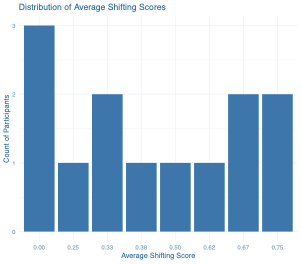
The subjects were asked which language they use more frequently in each domain (family, colleagues, neigbours, etc.). A shifting score was then computed for each participant in order to quantify the degree of language shifting:
Shifting Score = Number of domains using a language other than L1 / Total number of domains
The language shifting scores range from 0 (no language shifting) to 0.75
Study participants
There were 13 participants who met the following criteria:
- Female
- Immigrated to Germany as adults (≥ 18 years)
- L1 is a language other than German
- High degree of German proficiency (very high self-rating for all four language skills: listening, speaking, reading, writing)
- Partnership with a German spouse (married or in an unmarried long-term relationship)
- Common household language is German
- Highly educated (M.A. minimum)
- Resided in Germany between 5 and 15 years
- Aged between 23 and 45
- Ethnically Isolated immigrants
Research Questions
This study seeks to address the following research questions:
- How the geographical proximity of L1 contacts influences the language maintenance?
- How the frequency of contact influences the language maintenance?
- The distribution of L1/L2 speakers in the network. How this distribution in the primary and secondary network correlates with language maintenance?
- What is the role of kin in the network?
- How are multiplexity and sub-networks interrelated? Which contents and activities are most prevalent within specific sub-networks?
Basic Network compositional and structural features
The network size of participants ranged between 1 to 15, with the questionnaire having capacity of maximum 15 alters (Figure 2). Figures 3 and 4 display the distribution of L1 and non-L1 speakers in the primary (the most important individuals in ego’s network) and secondary (other individuals in the network).

Geographical Proximity of L1 and non-L1 speakers
The vicinity of participants’ contacts was coded using on a 5-point scale (Same home: 1, Neighbour: 2, Same city: 3, Germany: 4, Another country: 5). The median was then calculated for both the L1 and non-L1 speakers for each participant as shown in Figures 5 and 6.
The Spearman's rank correlation coefficient (ρ) of -0.044 suggests a weak negative correlation between speakers’ language maintenance and the geographical proximity of their L1-speaking contacts. However, this correlation was not statistically significant, with a p-value of 0.74.
Geographical Proximity of kins
Very few kins in the close vicinity makes the correlation analysis of kins’ geographical proximity impossible.
| Min | Max | Mean | Median |
| 1 | 5 | 4.68 | 5 |
Frequency of contact with L1 Speakers and Language Maintenance
The frequency of contact was coded on a scale of 8 points (from Everyday: 8 to Less than once a year: 1).
The results shows that there is a weak negative correlation (rho ≈ -0.106) between the frequency of contact with L1 speakers and shifting score, but this correlation is not statistically significant at neither the conventional significance level of 0.05 nor the determined level of 0.1 (p-value = 0.4359).
The distribution of L1/L2 speakers in the primary and secondary networks
A lower ratio of L1 to non-L1 speakers in both primary and secondary networks (figures 3 and 4 above) is associated with a negative correlation to language shifting. However, this correlation did not achieve statistical significance.
Primary Network: ρ= -0.176 (p-value= 0.225)
Secondary Network: ρ= -0.216 (p-value = 0.130)
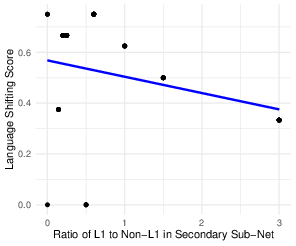
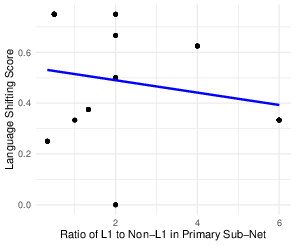
Multiplexity of ties in the sub-networks
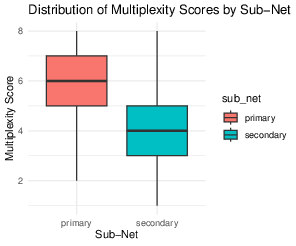
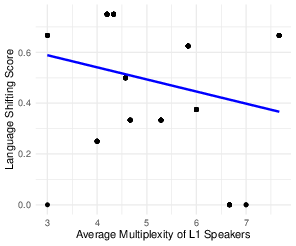
The participants were asked which contact in their network they refer to for the following eight important matters and an overall multiplexity score was calculated both for L1 versus non-L1 speakers and primary versus secondary speakers:
- Advice: Who do you turn to for advice?
- Borrow: Who would you borrow money from or who would you lend money to?
- Finances: What if things get really tight financially?
- Personal matters: What if you need emotional support?
- Work: What if you need to make an important decision for work?
- Sport
- Free time activities (e.g. dance, film, party, etc.)
- Other activities
The results indicated a statistically significant difference in multiplexity between primary and secondary sub-nets. Furthermore, it was also shown that a higher multiplexity of ties with L1 speakers positively associated with the language maintenance of speakers.
- Primary vs. Secondary Nets: W = 2358.5 (p-value =0.00000002056)
- Multiplexity of L1 speakers: ρ= -0.321 (p-value= 0.0006914)
Content differences between Sub-Nets
The same eight activities and matters used to calculate multiplexity were employed to assess the roles of L1 and non-L1 speakers within the whole network, as well as within primary and secondary networks. The analysis revealed that, with the exception of sporting activities, L1 speakers were generally more engaged in the questioned activities. However, the pattern differed when comparing primary to secondary networks. In the primary network, similar tot he whole network, L1 speakers were the preferred contacts for all activities and matters except sports, while in the secondary network, L2 speak ers were the preferred contacts for everything except financial concerns and leisure activities
Conclusion
The findings of the present study are largely consistent with those of Stoessel (2002). Both investigations confirmed the crucial influence of tie multiplexity and the different contents of sub-networks. Nonetheless, our study did not confirm the effect of geographical proximity that Stoessel observed in her study. A comparative summary of the results from both studies is presented in the following table.
| Research Question | Stoessel (2002) | The Present Study |
|---|---|---|
| Geographical Proximity of L1 | Stronger maintainers had more L1 in closer vicinity | No Significant Correlation |
| Frequency of Contact With L1 | No correlation | Positive but not significant |
| Distribution of L1/L2 | Higher maintainers had higher L1/L2 in the secondary network | L1/L2 ratio in both nets correlate positively with maintenance but not significantly |
| The Role of Kin | No result | No result |
| Multiplexity and Sub-Networks | More multiplex contacts in primary network | More multiplex contacts in primary network |
| Contents And Activities In Sub-Nets | Content difference between 2 networks | Content difference between 2 networks |
